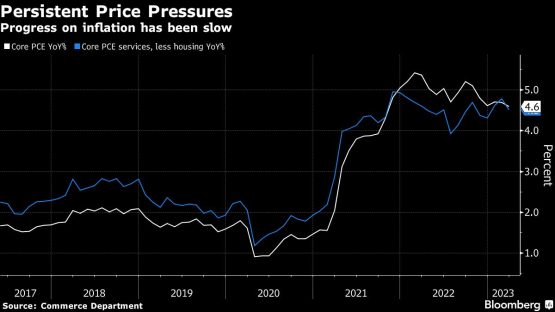The Federal Reserve is expected to deliver a 25 basis-point interest-rate increase and signal a pause in its aggressive hiking campaign, amid persistent financial-market turmoil and renewed pressure from lawmakers to back off.
Fed watchers expect the US central bank will deliver its final rate hike for a while on Wednesday, with tighter lending conditions and signs of a slowing economy suggesting inflation will cool more meaningfully in the months ahead. The move would bring the federal funds rate to a range of 5% to 5.25%, the highest since 2007.
A plunge in regional bank stocks following the collapse of First Republic Bank earlier this week has increased some bets that the Fed will pause this week, though policymakers have so far divorced interest-rate policy from their tools to shore up the banking sector.
“It seems apparent that they’re going to hike,” said Michael Feroli, chief US economist for JPMorgan Chase & Co. “You’re also hearing more and more about a pause. So it seems like, yeah, they want to pause but they know the inflation job isn’t finished here.”
The decision will be released at 2 p.m. in Washington, followed 30 minutes later by Chair Jerome Powell’s press conference. The Fed is not releasing updated rate and economic forecasts this week.
A quarter percentage point increase would be the third straight hike of that magnitude and would book-end one of the Fed’s fastest tightening campaigns in its 109-year history.
Several progressive lawmakers, including Senators Elizabeth Warren and Bernie Sanders, urged Powell to stop raising rates, and warned in a letter Tuesday that the bank turmoil and cumulative rate hikes “leave our economy even more vulnerable to an overreaction by the Fed.”
US equity futures edged higher in Asia after a selloff in regional lenders sent the S&P 500 down 1.2% in New York. Shares in Asia fell Wednesday.
While the inflation rate remains far above the Fed’s 2% target, some cooling in key components of the economy — including consumer spending and services inflation — hint that there may be some price relief in the second half of the year. Officials have also pointed to a pullback in lending, stemming from the recent bank failures, as a factor that will weigh on economic activity.
FOMC statement
Any signal that the Fed may pause — either in the Federal Open Market Committee’s statement or Powell’s press conference — will likely be couched by language suggesting officials aren’t necessarily done.
“The Fed still has to stay focused on inflation as No. 1,” said Citigroup Inc. economist Veronica Clark. “They have all these other tools to deal with financial stability issues, but inflation or price stability is still very much an issue.”
In March, officials tweaked the statement to say that “some additional policy firming may be appropriate,” softening previous language that “ongoing increases” would likely be needed. They may update it again to say that more rate increases will depend on how the data evolve, Feroli said.
What Bloomberg Economics Says…
“Signs of softening economic data and tightening credit will likely drive a consensus on the committee that rates are sufficiently restrictive – hinting at a bias to pause at the next meeting. But with inflation stubbornly elevated, Fed Chair Jerome Powell will stop short of assuring markets that a pause is a done deal — or that rate cuts are imminent.”
— Anna Wong, chief US economist
The press conference will “give Powell the opportunity to explain a little further what they’re thinking,” Feroli added. That could be challenging for Powell, who will want to avoid sending a message that the Fed sees its mission as accomplished.
Press conference
While First Republic’s collapse may not deter policymakers from raising rates Wednesday, the Fed chief will face questions about potential spillovers to other banks.
“We think this is only the very early stages of the chronic phase and that for every First Republic or Silicon Valley Bank there will be hundreds of smaller and mid-sized US banks that will act more conservatively in the months ahead,” Evercore ISI’s Krishna Guha wrote in a note to clients this week.
This will also be the first public appearance of a Fed official since the Fed published a report Friday on its failure to adequately supervise SVB.
Further developments in the banking sector, and the extent to which they tighten lending, will add to the likely bumpy nature of monetary policy in the next few months.
While some officials have said the central bank may need to resume rate increases after they pause, a key question for Fed watchers is what it’ll take for policymakers to cut rates. With staff and officials eyeing a recession later this year, markets have priced in easing as early as September. Still, no Fed official forecast a rate cut this year when they submitted economic projections in March.
Dissents
The more nuanced economic landscape may put an end to an era of unanimity among Fed officials. Chicago Fed President Austan Goolsbee, the newest FOMC member and a voter this year, argued that policymakers should exercise “patience and prudence” in the months ahead to fully assess how banking stress is working through the economy.

While other officials backed another a quarter-point hike this month, Goolsbee refrained from committing his support, paving the way for a potential dissent at this month’s meeting, or in the near future.
The looming US debt ceiling could also prove problematic for the Fed, as concerned markets contribute to tighter financial conditions. Powell is likely to echo previous messages calling for the borrowing limit to be raised.
© 2023 Bloomberg

